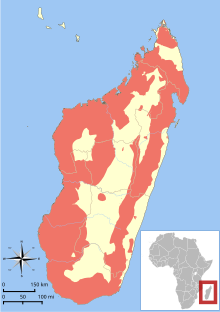
Back Lemur Afrikaans ليمور Arabic ليمور ARZ Lemuroidea AST লেমুর Bengali/Bangla Polumajmuni BS Lemuroïdeus Catalan Lemuroidea CEB Lemurer Danish Lemuroidea German
| Lemurs Temporal range:
| |
|---|---|

| |
| A sample of lemur diversity; 8 of 15 biological genera are depicted (from top, left to right): Lemur, Propithecus, Daubentonia, †Archaeoindris, Microcebus, Lepilemur, Eulemur, Varecia. | |
| Scientific classification | |
| Domain: | Eukaryota |
| Kingdom: | Animalia |
| Phylum: | Chordata |
| Class: | Mammalia |
| Order: | Primates |
| Suborder: | Strepsirrhini |
| Infraorder: | Lemuriformes |
| Superfamily: | Lemuroidea Gray 1821 |
| Families | |
| Diversity | |
| About 100 living species | |

| |
| Range of all lemur species[3] | |
Lemurs (/ˈliːmər/ ⓘ LEE-mər) (from Latin lemures – "ghosts" or "spirits") are wet-nosed primates of the superfamily Lemuroidea (/lɛmjʊˈrɔɪdiə/),[4] divided into 8 families and consisting of 15 genera and around 100 existing species. They are endemic to the island of Madagascar. Most existing lemurs are small, have a pointed snout, large eyes, and a long tail. They chiefly live in trees and are active at night.
Lemurs share resemblance with other primates, but evolved independently from monkeys and apes. Due to Madagascar's highly seasonal climate, lemur evolution has produced a level of species diversity rivaling that of any other primate group.
Lemurs range in weight from the 30-gram (1.1 oz) mouse lemur to the 9-kilogram (20 lb) indri. Since the arrival of humans on the island around 2,000 years ago, over a dozen species of "giant lemurs" larger than living lemur species have become extinct, including the gorilla-sized Archaeoindris. Lemurs share many common basal primate traits, such as divergent digits on their hands and feet, and nails instead of claws (in most species). However, their brain-to-body size ratio is smaller than that of anthropoid primates. As with all strepsirrhine primates, they have a "wet nose" (rhinarium).
Lemurs are generally the most social of the strepsirrhine primates, living in groups known as troops. They communicate more with scents and vocalizations than with visual signals. Lemurs have a relatively low basal metabolic rate, and as a result may exhibit dormancy such as hibernation or torpor. They also have seasonal breeding and female social dominance. Most eat a wide variety of fruits and leaves, while some are specialists. Two species of lemurs may coexist in the same forest due to different diets.
Lemur research during the 18th and 19th centuries focused on taxonomy and specimen collection. Modern studies of lemur ecology and behavior did not begin in earnest until the 1950s and 1960s. Initially hindered by political issues on Madagascar during the mid-1970s, field studies resumed in the 1980s. Lemurs are important for research because their mix of ancestral characteristics and traits shared with anthropoid primates can yield insights on primate and human evolution.Most species have been discovered or promoted to full species status since the 1990s; however, lemur taxonomic classification is controversial and depends on which species concept is used.
Many lemur species remain endangered due to habitat loss and hunting. Although local traditions, such as fady, generally help protect lemurs and their forests, illegal logging, economic privation and political instability conspire to thwart conservation efforts. Because of these threats and their declining numbers, the International Union for Conservation of Nature (IUCN) considers lemurs to be the world's most endangered mammals, noting that as of 2013[update] up to 90% of all lemur species confront the threat of extinction in the wild within the next 20 to 25 years. Ring-tailed lemurs are an iconic flagship species. Collectively, lemurs exemplify the biodiverse fauna of Madagascar and have facilitated the emergence of eco-tourism. In addition, conservation organizations increasingly seek to implement community-based approaches to save lemur species and promote sustainability.
- ^ Cite error: The named reference
2006Godinotwas invoked but never defined (see the help page). - ^ Sussman 2003, pp. 149–229.
- ^ Cite error: The named reference
IUCNwas invoked but never defined (see the help page). - ^ "lemur". The Chambers Dictionary (9th ed.). Chambers. 2003. ISBN 0-550-10105-5.
© MMXXIII Rich X Search. We shall prevail. All rights reserved. Rich X Search